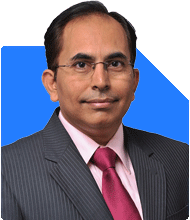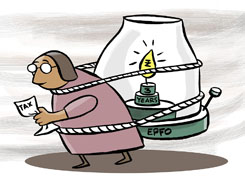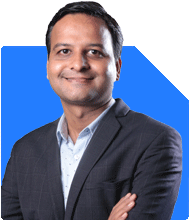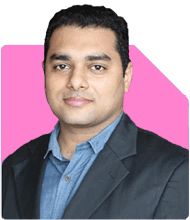am 45 yrs old. 1.5 lac my take home salary( including annual bonus).18k from rent. Mother's pension+interest earned on her FD's 15k pm.3 houses of Rs 60L,75L and 30L. 1 Plot 30 Lac. FD 32 Lac, shares 2.15 lac. Sip 25k, ppf 19.5 lac, pf 20.7 lac, nps 9.7 lac current value, gold bonds 8 lac current value. One Home loan 19.8 lac left (I pay 15k extra in each emi so only 4 yrs left hence will finish my 20 yrs home loan within 10 yrs itself. Car loan 7 lac left for 5 yrs. Gold jewellery worth 30 lac. Am I going fine in my savings? We are a simple traditional family and believe on savings investments. Expenses 48k home loan emi. Car 13600 emi School fees 21k pm total for 2 kids. house hold expenses 15k pm Other expenses 10-12k pm As my calculation I save around 40-45k pm. Will 43 cr be enough for me after retirement as me and my wife plan to lead a simple cosy life. Can I retire at 57-58 yrs of age.
Ans: It’s great to see your savings mindset and disciplined investment habit. You have a strong asset base and clear goals. Let us assess your situation critically and provide a well-rounded strategy.
Evaluating Your Current Wealth Position
Age: 45 years
Take?home salary: Rs.1.5 lakh per month (including bonus)
Rental income: Rs.18,000 per month
Mother’s pension + FD interest: Rs.15,000 per month
Total monthly inflows: Rs.1.83 lakh
Your assured cash flows are strong. You also have assets across various categories:
Residential properties: Rs.60L, Rs.75L, Rs.30L
Plot: Rs.30L
FD holding: Rs.32L
Shares: Rs.2.15L
Mutual Fund SIP: Rs.25k per month
PPF balance: Rs.19.5L
PF: Rs.20.7L
NPS: Rs.9.7L
Sovereign Gold Bonds: Rs.8L
Gold jewellery: Rs.30L
Your known liabilities:
Home loan: Rs.19.8L remaining, 10 years tenure left
Car loan: Rs.7L remaining, 5 years tenure
Monthly obligations:
Home EMI: Rs.48k
Car EMI: Rs.13,600
Children’s school fees: Rs.21k
Household expenses: Rs.15k
Other expenses: Rs.10–12k
Est. monthly savings: Rs.40–45k
Your query: is this progress good? Will Rs.4.3 crore at retirement suffice? Can you retire at 57–58 years? Let’s assess.
Income Sustainability in the Near Term
Your current monthly inflows (excluding salary) total Rs.33,000. This is helpful but modest.
Your salary is major source. Continue managing both active and passive inflows carefully.
Debt Situation
Home loan at Rs.19.8L: you pay Rs.15k extra EMI. That shortens tenure and lowers interest.
Car loan Rs.7L will finish in 5 years. Good.
Better to accelerate home loan repayment using surplus cash.
No need for new debt. The aim is to be debt?free before retirement.
Expense Analysis & Savings Health
Total monthly expenses (fixed + variable): around Rs.1.17 lakh.
With monthly net inflows at Rs.1.83 lakh, you save Rs.66,000. This matches your statement of ~40–45k saving after expenses.
Your current saving rate (~36%) is strong for your age.
It’s good you maintain a prudent expense ratio of roughly 36%.
Assessing Retirement Corpus Need
You target retirement at 57–58 years—12–13 years from now.
You estimate needing Rs.4.3 crore corpus at retirement. Let us examine adequacy.
Typical assumptions:
Post-retirement annual expense: Rs.15 lakh (approx Rs.1.25 lakh monthly)
Life after 58 years may span 30 years (till age 88)
To generate inflation-adjusted Rs.15 lakh annually, corpus of Rs.4–5 crore seems reasonable, assuming moderate withdrawal and portfolio returns.
Hence, your Rs.4.3 crore goal appears aligned with a simple conservative model.
Projecting Your Corpus Accumulation
You currently hold:
Real estate: Rs.1.95 crore
Financial assets (FD, PPF, PF, NPS, SGB, shares): total approx Rs.1.12 crore
Ongoing SIPs: Rs.25k/month
Over the next 13 years:
Your PF, PPF, NPS will grow via contributions and interest
SIP contributions will compound
Debt obligations will reduce
With disciplined investing and no major lifestyle inflation, you are on track to build Rs.4–5 crore corpus.
But, a focused strategy is needed. Let us outline it.
Strategy to Optimize Current Assets
Keep your property. It gives rental of Rs.18k per month.
Do not convert property into pension-income real estate. It takes effort.
Maintain FD of Rs.32L as liquid reserve.
Keep NPS, PF, PPF as part of retirement mix. All are tax-efficient vehicles.
Shares: continue small equity exposure via SIP to benefit from long-term growth.
Sovereign Gold Bonds and jewellery: maintain 5–8% of portfolio weight.
Debt Reduction Plan
Home loan: pay extra Rs.15k EMI. This reduces total interest materially.
Aim to close home loan before age 55 if possible.
Car loan will end in 5 years. Then redirect Rs.13.6k towards investments or loan prepayment.
Eliminate debt before retirement to reduce financial burden and increase monthly surplus.
SIP Planning & Asset Allocation
Current SIP of Rs.25k/month is good. But you can increase selectively.
After home and car loan finish, redirect that EMI into SIP.
Increase SIP by at least Rs.25–30k per month over the next 5–7 years.
Maintain an asset allocation ratio: 60% debt/fixed income, 30% equity, 10% gold.
Do not invest in index funds—they lack active risk management.
Do not use direct funds—they lack guidance, professional review, and rebalancing.
Use actively managed equity and hybrid funds, via regular plans under Certified Financial Planner’s guidance, to ensure disciplined growth and periodic portfolio reviews.
Emergency & Contingency Planning
You need liquid funds for emergencies or medical events.
Maintain 6–12 months of expenses (Rs.7–8 lakh) in liquid fund or sweep-in FD.
Keep a separate buffer for your mother if needed.
Consider health cover for yourself and family, as medical costs rise at older age.
Children’s Educational Planning
Your children’s school fees are Rs.21k per month total.
Your current savings and income can support their schooling until graduation.
But consider:
Future educational goals (professional courses, abroad, etc.)
Build goal-based corpus via separate SIPs for higher education.
Rebalance once fees are stable or decrease after college is over.
Tax Efficiency and Investment Mix
House rent helps reduce taxable income partly via standard deduction.
PPF and PF contributions are tax-efficient.
NPS contributions get 80CCD benefits, and tier 1 withdrawal gets favourable tax treatment.
FD interest and rental income are fully taxable; manage via slab planning.
As per new MF tax rules:
Equity mutual fund LTCG above Rs.1.25 lakh taxed at 12.5%
STCG at 20%
Debt mutual fund gains taxed as per income slab
Plan mutual fund withdrawals via SIP SWP or goal-based exits to optimise tax.
Retirement Income Generation Strategy
Goal: retire at 57–58 years, staying financially comfortable.
Post?retirement: You will rely on:
Rental income
Systematic Withdrawal from mutual fund corpus
Interest from PF, PPF, NPS, FD
Pension (if any under NPS Tier 2)
To ensure monthly income of Rs.1.25 lakh:
Rental + pensions + interest together should cover Rs.60k
SWP from mutual funds to cover remaining Rs.65k
With Rs.4–5 crore corpus, safe withdrawal rate of ~6% yields Rs.25–30k per month depending on returns
Add to interest and rent, it totals required amount
Adjust based on actual return trajectories and inflation.
Portfolio Rebalancing Over Time
As you near age 55–58:
Gradually reduce equity exposure while increasing debt allocation
Shift part of accumulated equity portfolio to hybrid or debt instruments
Keep monthly SWP going post-retirement
Maintain flexibility and avoid rigid options like annuities
Lifestyle, Inflation and Expense Management
Projected inflation of 6–7% annually means cost of living in future doubles every 10–12 years.
If today you spend Rs.1.17 lakh, at 58 years it could be Rs.4–5 lakh.
Your corpus needs to cover this indexed expense for 30+ years.
Simple cosy lifestyle may still escalate due to medical and travel ambitions.
Keep reviewing lifestyle plans every 5 years.
Contingency for Medical, Long?Term Care and Caregiving
In later years, medical expenses can be high.
Need to plan for long?term care or assisted living.
Consider personal health cover for family.
Keep liquidity for unexpected medical events.
Build critical illness top?up plan if not already.
Plan will/estate, with instructions for elder care.
Estate Planning and Succession Readiness
By age 55, ensure legal and succession matters are in order:
Draft or update your will
Nominate family members in all investment and bank accounts
Keep property documents accessible
Discuss financial plan with spouse and children
Ensure they understand how to access accounts and investments
This gives peace of mind and clarity for family.
Review Plan Annually with Certified Financial Planner
An annual review helps to:
Track progress on home loan repayment
Measure corpus accumulation vs target
Rebalance allocation to match age and goals
Adjust for change in expenses or incomes
Refine retirement age goal based on updated data
Consistent monitoring ensures you stay on track.
Risks to Watch Out For
Medical emergencies or sudden lifestyle changes
Market corrections impacting SIP returns
Asset illiquidity, especially property
Inflation eroding monthly spending power
Underestimating future tax or rule changes
Proper planning helps mitigate these risks.
Final Insights
You are saving well and building wealth steadily
Your target corpus of Rs.4.3 crore seems realistic
Debt is under control and will be cleared before retirement
Continue active investing via SIPs, increasing gradually
Avoid passive index or direct funds; choose active funds via CFP?supported regular plans
Balance portfolio across equity, debt, gold for stability
Plan health cover, estate documentation, and will in place
Review annually to stay aligned with your goal
Rs.4.3 crore at retirement, aligned with rental, pension, and SWP, can sustain your desired post-retirement lifestyle
Your disciplined savings and investments provide a solid foundation.
Retirement at 57–58 is achievable with proper execution.
Best Regards,
K. Ramalingam, MBA, CFP
Chief Financial Planner
www.holisticinvestment.in
https://www.youtube.com/@HolisticInvestment



























